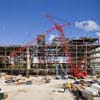State Allocation Board Leaves Level 1 Developer Fees Unchanged And Decreases School Facility Program Grant For 2010

February 2010
Number 4
CLIENT NEWS BRIEF
STATE ALLOCATION BOARD LEAVES LEVEL 1 DEVELOPER FEES
UNCHANGED AND DECREASES SCHOOL FACILITY
PROGRAM GRANT FOR 2010
Every other year at its January meeting, the State Allocation Board ("SAB") adopts an
inflationary adjustment to the statutory school impact fee, commonly referred to as the
"Level 1" developer fee. On January 27, 2010, the SAB elected to leave the current Level
1 fee unchanged. Accordingly, the residential Level 1 fee remains at $2.97 per square
foot, and the commercial Level 1 fee remains at $0.47 per square foot. The SAB also
voted to decrease funding for the School Facility Program ("SFP") grant by 6.74%.
Construction funding that was approved by the SAB before January 1, 2010, will not be
subject to this decrease.
Although the SAB elected to leave the Level 1 fees unchanged, school districts should
consider reviewing their justification studies to ensure that they remain sufficiently
current and accurate. In light of the statewide economic slowdown, assumptions in
prior studies may have changed. To avoid or defeat potential challenges from
developers that the Level 1 fees are no longer justified due to changed economic and
development circumstances, districts should evaluate whether a new or updated
justification study is warranted.
In contrast to Level 1 fees, Level 2 fees must be adopted annually through approval of a
School Facility Needs Analysis ("SFNA"). Level 2 fees are also not automatically subject
to an inflationary adjustment every other year. Level 2 fees are determined by
application of a specific formula as set forth in Government Code section 65995.6. That
formula considers the then applicable SFP grant amount as the basis for determining
the anticipated cost of school construction. In light of the SAB's decision to decrease
SFP grant amounts by 6.74%, when a future SFNA is adopted, one of the key assumed
costs in the formula will have to be adjusted downward. Depending on how other
factors play out, the result could be a lower Level 2 fee.
To assist schools in dealing with numerous developer fee issues, Lozano Smith's Facilities
and Business Practice Group publishes its Developer Fee Handbook for School Facilities:
A User's Guide to Qualifying for, Imposing, Increasing, Collecting, Using and Accounting
for School Impact Fees in California. The handbook is designed to help school districts
Page 6
As the information contained herein is necessarily general, its application to a particular set of facts
and circumstances may vary. For this reason, this News Brief does not constitute legal advice. We
recommend that you consult with your counsel prior to acting on the information contained herein.
Written by:
February 2010
Number 4
CLIENT NEWS BRIEF
reduce their legal costs by providing comprehensive information regarding California
law and process for school impact fees. Toward this end, the handbook contains
procedures, time lines, checklists and forms to be used when adopting fees and/or fee
increases. Our 2010 updates to the handbook will be forthcoming shortly.
For more information on the Developer Fee Handbook, or to order a copy, please visit
our website, contact our Client Services department at: clientservices@lozanosmith.com,
or call (800) 445-9430.
Trevin E. Sims
Shareholder
Los Angeles Office
tsims@lozanosmith.com
Kevin Angstenberger
Associate
Walnut Creek Office
kangstenberger@lozanosmith.com
Harold M. Freiman
Shareholder
Walnut Creek Office
hfreiman@lozanosmith.com
� 2010 Lozano Smith Page 7
Number 4
CLIENT NEWS BRIEF
STATE ALLOCATION BOARD LEAVES LEVEL 1 DEVELOPER FEES
UNCHANGED AND DECREASES SCHOOL FACILITY
PROGRAM GRANT FOR 2010
Every other year at its January meeting, the State Allocation Board ("SAB") adopts an
inflationary adjustment to the statutory school impact fee, commonly referred to as the
"Level 1" developer fee. On January 27, 2010, the SAB elected to leave the current Level
1 fee unchanged. Accordingly, the residential Level 1 fee remains at $2.97 per square
foot, and the commercial Level 1 fee remains at $0.47 per square foot. The SAB also
voted to decrease funding for the School Facility Program ("SFP") grant by 6.74%.
Construction funding that was approved by the SAB before January 1, 2010, will not be
subject to this decrease.
Although the SAB elected to leave the Level 1 fees unchanged, school districts should
consider reviewing their justification studies to ensure that they remain sufficiently
current and accurate. In light of the statewide economic slowdown, assumptions in
prior studies may have changed. To avoid or defeat potential challenges from
developers that the Level 1 fees are no longer justified due to changed economic and
development circumstances, districts should evaluate whether a new or updated
justification study is warranted.
In contrast to Level 1 fees, Level 2 fees must be adopted annually through approval of a
School Facility Needs Analysis ("SFNA"). Level 2 fees are also not automatically subject
to an inflationary adjustment every other year. Level 2 fees are determined by
application of a specific formula as set forth in Government Code section 65995.6. That
formula considers the then applicable SFP grant amount as the basis for determining
the anticipated cost of school construction. In light of the SAB's decision to decrease
SFP grant amounts by 6.74%, when a future SFNA is adopted, one of the key assumed
costs in the formula will have to be adjusted downward. Depending on how other
factors play out, the result could be a lower Level 2 fee.
To assist schools in dealing with numerous developer fee issues, Lozano Smith's Facilities
and Business Practice Group publishes its Developer Fee Handbook for School Facilities:
A User's Guide to Qualifying for, Imposing, Increasing, Collecting, Using and Accounting
for School Impact Fees in California. The handbook is designed to help school districts
Page 6
As the information contained herein is necessarily general, its application to a particular set of facts
and circumstances may vary. For this reason, this News Brief does not constitute legal advice. We
recommend that you consult with your counsel prior to acting on the information contained herein.
Written by:
February 2010
Number 4
CLIENT NEWS BRIEF
reduce their legal costs by providing comprehensive information regarding California
law and process for school impact fees. Toward this end, the handbook contains
procedures, time lines, checklists and forms to be used when adopting fees and/or fee
increases. Our 2010 updates to the handbook will be forthcoming shortly.
For more information on the Developer Fee Handbook, or to order a copy, please visit
our website, contact our Client Services department at: clientservices@lozanosmith.com,
or call (800) 445-9430.
Trevin E. Sims
Shareholder
Los Angeles Office
tsims@lozanosmith.com
Kevin Angstenberger
Associate
Walnut Creek Office
kangstenberger@lozanosmith.com
Harold M. Freiman
Shareholder
Walnut Creek Office
hfreiman@lozanosmith.com
� 2010 Lozano Smith Page 7
As the information contained herein is necessarily general, its application to a particular set of facts and circumstances may vary. For this reason, this News Brief does not constitute legal advice. We recommend that you consult with your counsel prior to acting on the information contained herein.






